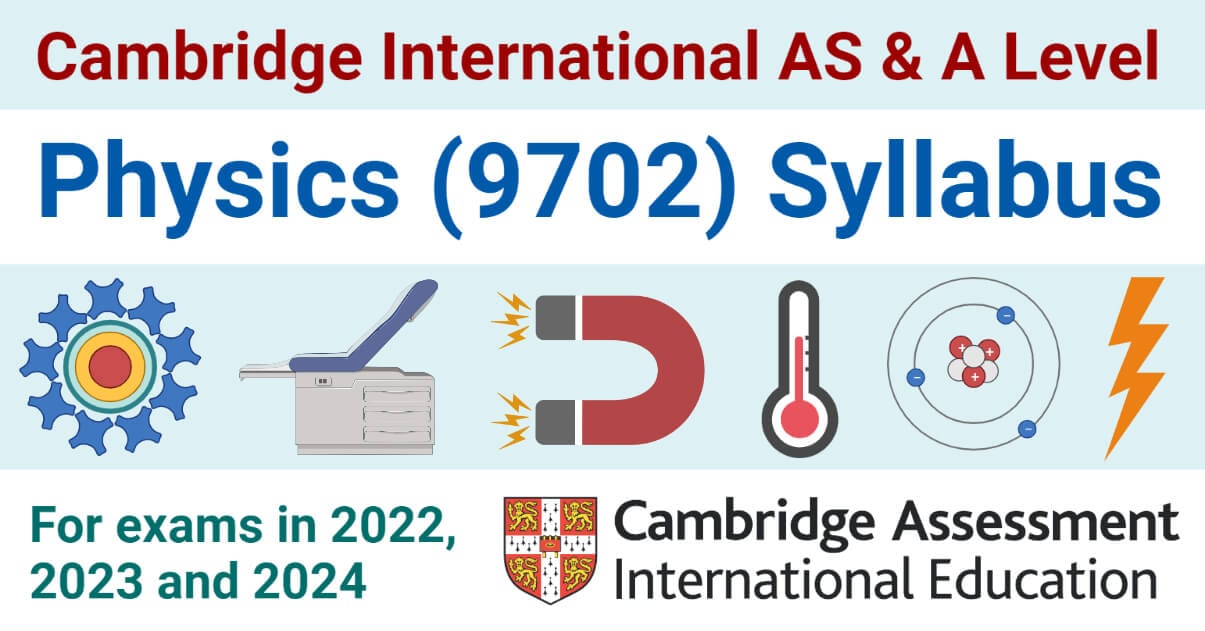Cambridge International AS & A Level Physics develops transferable skills, including handling data, practical problem-solving, and applying the scientific method. Learners develop relevant attitudes, such as concern for accuracy and precision, objectivity, integrity, inquiry, initiative, and inventiveness. They acquire the essential scientific skills required for progression to further studies or employment.

Interesting Science Videos
Key Concepts for Cambridge International AS & A Level Physics
Models of physical systems
Physics is the science that seeks to understand the behavior of the Universe. The development of models of physical systems is central to physics. Models simplify, explain, and predict how physical systems behave.
Testing predictions against evidence
Physical models are usually based on prior observations, and their predictions are tested to check that they are consistent with the behavior of the real world. This testing requires evidence, often obtained from experiments.
Mathematics as a language and problem-solving tool
Mathematics is integral to physics, as it is the language that is used to express physical principles and models. It is also a tool to analyze theoretical models, solve quantitative problems and produce predictions.
Matter, energy, and waves
Everything in the Universe comprises matter and/or energy. Waves are a key mechanism for the transfer of energy and are essential to many modern applications of physics.
Forces and fields
The way that matter and energy interact is through forces and fields. The behaviour of the Universe is governed by fundamental forces with different magnitudes that interact over different distances. Physics involves study of these interactions across distances ranging from the very small (quantum and particle physics) to the very large (astronomy and cosmology).
Cambridge AS Level Physics Syllabus
1. Physical quantities and units
1.1 Physical quantities
1.2 SI units
1.3 Errors and uncertainties
1.4 Scalars and vectors
2. Kinematics
2.1 Equations of motion
3. Dynamics
3.1 Momentum and Newton’s laws of motion
3.2 Non-uniform motion
3.3 Linear momentum and its conservation
4. Forces, density, and pressure
4.1 Turning effects of forces
4.2 Equilibrium of forces
4.3 Density and pressure
5. Work, energy, and power
5.1 Energy conservation
5.2 Gravitational potential energy and kinetic energy
6. Deformation of solids
6.1 Stress and strain
6.2 Elastic and plastic behaviour
7. Waves
7.1 Progressive waves
7.2 Transverse and longitudinal waves
7.3 Doppler effect for sound waves
7.4 Electromagnetic spectrum
7.5 Polarisation
8. Superposition
8.1 Stationary waves
8.2 Diffraction
8.3 Interference
8.4 The diffraction grating
9 Electricity
9.1 Electric current
9.2 Potential difference and power
9.3 Resistance and resistivity
10. D.C. circuits
10.1 Practical circuits
10.2 Kirchhoff’s laws
10.3 Potential dividers
11. Particle physics
11.1 Atoms, nuclei and radiation
11.2 Fundamental particles
Cambridge A Level Physics Syllabus
12. Motion in a circle
12.1 Kinematics of uniform circular motion
12.2 Centripetal acceleration
13. Gravitational fields
13.1 Gravitational field
13.2 Gravitational force between point masses
13.3 Gravitational field of a point mass
13.4 Gravitational potential
14. Temperature
14.1 Thermal equilibrium
14.2 Temperature scales
14.3 Specific heat capacity and specific latent heat
15. Ideal gases
15.1 The mole
15.2 Equation of state
15.3 Kinetic theory of gases
16. Thermodynamics
16.1 Internal energy
16.2 The first law of Thermodynamics
17. Oscillations
17.1 Simple harmonic oscillations
17.2 Energy in simple harmonic motion
17.3 Damped and forced oscillations, resonance
18. Electric fields
18.1 Electric fields and field lines
18.2 Uniform electric fields
18.3 Electric force between point charges
18.4 Electric field of a point charge
18.5 Electric potential
19. Capacitance
19.1 Capacitors and capacitance
19.2 Energy stored in a capacitor
19.3 Discharging a capacitor
20. Magnetic fields
20.1 Concept of a magnetic field
20.2 Force on a current-carrying conductor
20.3 Force on a moving charge
20.4 Magnetic fields due to currents
20.5 Electromagnetic induction
21. Alternating currents
21.1 Characteristics of alternating currents
21.2 Rectification and smoothing
22. Quantum physics
22.1 Energy and momentum of a photon
22.2 Photoelectric effect
22.3 Wave-particle duality
22.4 Energy levels in atoms and line spectra
23. Nuclear physics
23.1 Mass defect and nuclear binding energy
23.2 Radioactive decay
24. Medical physics
24.1 Production and use of ultrasound
24.2 Production and use of X-rays
24.3 PET scanning
25. Astronomy and cosmology
25.1 Standard candles
25.2 Stellar radii
25.3 Hubble’s law and the Big Bang theory
Details of the assessment
Paper 1 Multiple Choice
- Written paper, 1 hour 15 minutes, 40 marks
- Forty multiple-choice items of the four-choice type testing assessment objectives AO1 and AO2. Questions are based on the AS Level syllabus content.
Paper 2 AS Level Structured Questions
- Written paper, 1 hour 15 minutes, 60 marks
- Structured questions testing assessment objectives AO1 and AO2. Questions are based on the AS Level syllabus content.
Paper 3 Advanced Practical Skills
- Practical test, 2 hours, 40 marks
- This paper tests assessment objective AO3 in a practical context.
- Two questions assess the AS Level practical skills in the Practical assessment section of the syllabus. The content of the questions may be outside the syllabus content.
Paper 4 A Level Structured Questions
- Written paper, 2 hours, 100 marks
- Structured questions testing assessment objectives AO1 and AO2.
- Questions are based on the A Level syllabus; knowledge of material from the AS Level syllabus content will be required.
Paper 5 Planning, Analysis, and Evaluation
- Written paper, 1 hour 15 minutes, 30 marks
- Two questions testing assessment objective AO3.
- Questions are based on the A Level practical skills of planning, analysis, and evaluation but may require knowledge of practical skills from the AS Level syllabus. The content of the questions may be outside of the syllabus content.
Disclaimer: The syllabus and contents on this page are only used for educational purposes. If there are any copyright issues regarding the content, please email us at microbenotes@gmail.com.
References
Cambridge International AS & A Level Physics (9702) Syllabus
